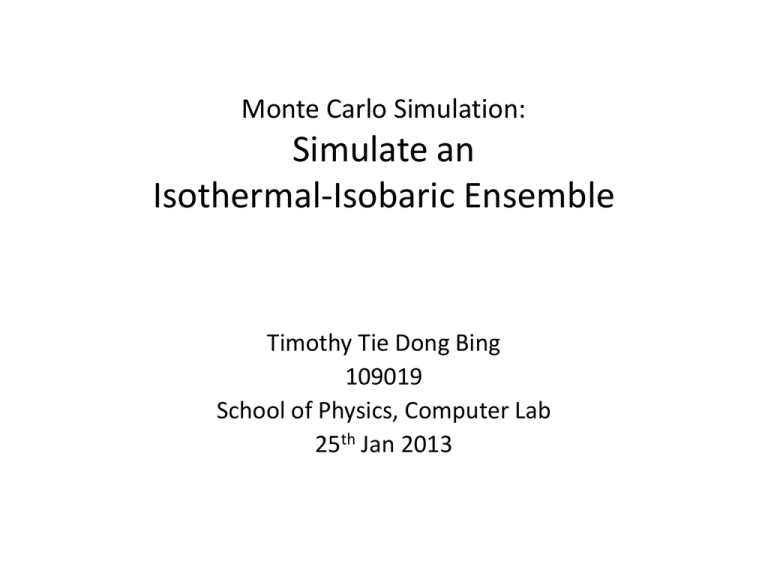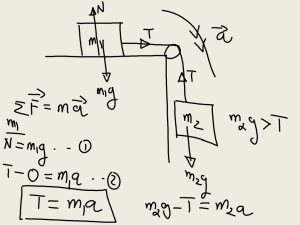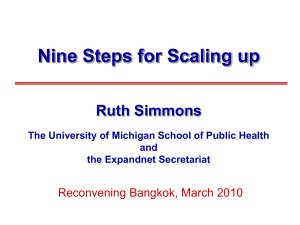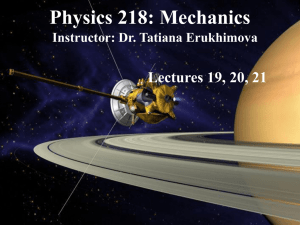Monte Carlo Simulation: Isothermal
advertisement

Monte Carlo Simulation: Simulate an Isothermal-Isobaric Ensemble Timothy Tie Dong Bing 109019 School of Physics, Computer Lab 25th Jan 2013 One of the greatest benefits of Monte Carlo simulations are that we can simulate any ensemble of interest. The general approach to deriving the methods consists of the following: 1. Determine the microstate probability distribution for the ensemble of interest. 2. Determine a set of Monte Carlo moves which accomplish changes in all of the fluctuating quantities in the ensemble. 3. Find acceptance criterion by imposing detailed balance. The isothermal-isobaric ensemble corresponds to constant 𝑇, 𝑃, 𝑁 conditions (specified parameters), when a system is held at constant temperature and pressure by connection to a heat and volume bath. That is, the system can exchange both energy and volume with its surroundings. In isothermal-isobaric ensemble, both the energy and the volume of a system fluctuate. Thus, Monte Carlo moves should be adopted to track the energy and volume of the system. Algorithm Defining parameters initposition[ ] -Allocate particle coordinates in space -Determine magnitude of each particle’s coordinate -Assign diameter for each particle end initposition Energy[] -Update potential energy by Lennard-Jones potential End Energy ------------------------------------------------------------------------------------Functions that determine initial position and initial energy Algorithm volumechange[] -Do test whether volume change is allowed or not from acceptance criterion (volaccprob). -Update new volume, new simulation box size, new potential energy -Determine scalefactor if successfully change the volume. -rescaling[] end volume change ------------------------------------------------------------------------------------Function that run and attempt to change volume and check change in energy if success Algorithm rescaling[] -Update rescaled coordinates and their magnitudes. end rescaling particlechange[dummy] -Attempt moving chosen particle[dummy]. -Recalculate energy difference. -Do test whether to move is accepted or not. -If yes, do overlap[] and putback[] tests to test whether the moved particle overlapped with any nearest particle or run out of the simulation box (periodic boundary conditions) end particlechange ------------------------------------------------------------------------------------Function that run and attempt to move particle and check change in energy if success Algorithm overlap[] -if overlap then return the particle being moved putback[] -if the particle moved out the boundary then put back the particle being moved main[P_,T_] -Initialize Boltzmann coefficient, 𝛽 -initposition[] -counters for volume change and particle move -For cyc <= cycles, For i <= number of particles, for every batch of NN particles perform one volumechange[] else perform particlechange[] ------------------------------------------------------------------------------------Main function that run the process to see how how energy fluctuates in isobaric-isothermal ensemble Algorithm -update density -collect data end main[] Display some variables -----------------------------------------------------------------------------------Main function that run the process to see how energy fluctuates in isobaric-isothermal ensemble But how do we have energy fluctuation in Monte Carlo simulation of isobaric-isothermal ensemble? In the simulation, we accomplish energy fluctuations using displacement moves and volume fluctuations using volume scaling moves. The acceptance criterion of displacement moves is 𝑎𝑐𝑐 𝑃12 = exp 𝑚𝑖𝑛 0, −𝛽∆𝑈 while for volume fluctuations, 𝑎𝑐𝑐 𝑃12 𝑉2 = exp 𝑚𝑖𝑛 0, 𝑁 𝑙𝑛 − 𝛽∆𝑈 − 𝛽𝑃∆𝑉 𝑉1 Energy Fluctuation: From the acceptance criterion of particle moves 𝑎𝑐𝑐 𝑃12 = exp 𝑚𝑖𝑛 0, −𝛽∆𝑈 For a system of particles interacting exclusively through a pairwise energy function of the form 𝑢 𝑟𝑖𝑗 = 𝑎𝑟𝑖𝑗−𝑛 The potential energy of the system is then calculated by summing the contributions from each pair of particles. Energy Fluctuation: The Lennard-Jones potentials involves two terms of this form, where 𝑛 = 12 and 𝑛 = 6, for instance, 𝑈 𝑟 = 4𝜖 𝜎 𝑟 12 𝜎 − 𝑟 6 where 𝜖 and 𝜎 are constants that set the energy and distance scale associated with the interaction. Energy Fluctuation: The initial coordinates of particles are taken to be coordinates of particles in a scaled FCC lattice. The potential is calculated from their interatomic interactions by using Lennard-Jones potential. A Monte Carlo move is made such that a random chosen particles makes a reasonable move, and the difference between the new potential energy and the old one is calculated to be tested using the acceptance criterion. If accepted, the old data will be replaced, else, the move is rejected and the old data remains. Energy Fluctuation: Check overlap and periodic conditions Each time a particle is successfully moved, it’s checked whether the latest coordinate of the particle overlaps with other nearby particles or went out of the simulation box. Volume Fluctuation Molecular systems We scale the positions of centers of mass of each molecule. Otherwise, we would greatly distort bonds in a way that would make the change in potential energy very unfavorable for acceptance of the move. When one scales the centers of mass, the considerations for changes in the differential volume 𝑁 elements associated with 𝛼 𝒓𝑁 → 𝒓 𝟏 𝟐 applies only to the 𝑁𝑚𝑜𝑙 degrees of freedom. Volume Fluctuation Molecular systems Thus the 𝑁 term appearing in the acceptance criterion for volume change is no longer the total number of atoms but 𝑁𝑚𝑜𝑙 : 𝑎𝑐𝑐 𝑃12 𝑉2 = min 1, 𝑉1 𝑁𝑚𝑜𝑙 𝑒 −𝛽∆𝑈−𝛽𝑃∆𝑉 Volume Fluctuation Log-volume scaling moves For specified 𝑇, 𝑃 that place systems near liquid-gas phase coexistence, or near the critical point, the natural volume fluctuations can be very large as the system traverses between the two phases. In these cases, the simple volume increments presented above can become inefficient because it will require many displacements ∆𝑉 to traverse between gas and liquid states. In such cases, it becomes much more efficient to propose random moves in the logarithm of the volume rather than the volume itself. Volume Fluctuation Log-volume scaling moves Thus, in this Monte Carlo simulation, we use logvolume scaling to simulate how volume in such ensemble change. Such log-volume scaling moves entail the following: 1. Pick a random value 𝛿(= ln ∆𝑉) on the uniform distribution −𝛿𝑚𝑎𝑥 , 𝛿𝑚𝑎𝑥 . 2. Let ∆𝑉 = exp(𝛿). 3. Update 𝑉 → 𝑉 + ∆𝑉 and scale the particle positions as before. Volume Fluctuation Log-volume scaling moves This modifies the acceptance criterion, 𝑁+1 𝑉2 𝑎𝑐𝑐 𝑃12 = min 1, 𝑒 −𝛽∆𝑈−𝛽𝑃∆𝑉 𝑉1 𝑉2 = exp 𝑚𝑖𝑛 0, 𝑁 + 1 𝑙𝑛 − 𝛽∆𝑈 − 𝛽𝑃∆𝑉 𝑉1 Notice the N+1 rather than N before. Volume Fluctuation Choice of 𝜹𝑽𝒎𝒂𝒙 Typically the maximum volume displacement is adjusted so that the average acceptance ration is roughly 30 − 50%. Too small values of this parameter result in a slow exploration of volume space. Too large will result in configurations with core overlaps upon scaling the volume down. Thus, choose a suitable volume displacement probability is important. Volume Fluctuation Rescaling Upon the volume change, scale the particle positions uniformly. If molecules are being studied, the centers of mass of the molecules are scaled uniformly, rather than the individual atoms. In scaling the positions of the particles, we keep the dimensionless or scaled positions the same: 𝑥1 𝑦1 𝑧𝑁 𝑠𝑥,1 , 𝑠𝑦,1 , … , 𝑠𝑧,𝑁 = , ,…, 𝐿 𝐿 𝐿 𝑁 𝒓 𝒔𝑁 = 𝐿 Volume Fluctuation Computing the potential energy After a volume scaling move, the total potential energy of the system needs to be recalculated. The new energy can be computed simply from a scaling of the old energy, −𝑛 𝐿2 𝑈2 = 𝑈1 𝐿1 The Lennard-Jones potentials, again, involves two terms of this form, where 𝑛 = 12 and 𝑛 = 6. In summary, a typical 𝑁𝑃𝑇 simulation entails the following: 𝑎𝑐𝑐 1. Random particle displacement moves, with 𝑃12 = exp 𝑚𝑖𝑛 0, −𝛽∆𝑈 A random number 𝑟 is drawn in [0.0,1.0) and the 𝑎𝑐𝑐 move is accepted if 𝑃12 > 𝑟. 2. Random volume scaling moves, with 𝑉2 𝑎𝑐𝑐 𝑃12 = exp 𝑚𝑖𝑛 0, 𝑁 𝑙𝑛 − 𝛽∆𝑈 − 𝛽𝑃∆𝑉 𝑉1 A random number 𝑟 is drawn in [0.0,1.0) and the 𝑎𝑐𝑐 move is accepted if 𝑃12 > 𝑟. Frequency of moves How frequent should we make a move? In an 𝑁𝑃𝑇 simulation, particle displacement moves typically require an expense proportional to 𝑁, while volume scaling moves scale as 𝑁 2 . It is therefore customary to attempt one volume scaling move, on average, for every 𝑁 displacement moves attempted. The random component of move selection is extremely important to the correct convergence of the Markov chain. This, one should not explicitly cycle through the 𝑁 particles performing displacement moves and then perform a volume scaling attempt. Such regularity of moves, without a random component, will ultimately bias the stationary distribution. Reference J.M. Thijssen, "Computational Physics" (University Press, Cambridge, United Kingdom, Second Edition, 2007). Daan Frenkel and Berend Smit, "Understanding Molecular Simulation From Algorithms to Applications" (Academic Press, Second Edition, 2002). Marjolein Dijkstra, “Computational Material Science” (Lecture 5, Utrech University). M Scott Shell, “Monte Carlo simulations in other ensembles” (Lecture Note, 2012).








